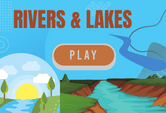Quiz Game On Rivers And Lakes Online
This Quiz Game On Rivers And Lakes Online is for students in 5th, 6th, 7th, 8th grades. Can you tell the difference between a lake and a river? A lake is an enclosed body of water while a river is an elongated flowing mass of water. Rivers take their rise from a source which could be a mountain and flow downhill until they meet an area of resistance. Such areas are usually characterised by flood plains and deltas. Rivers have given rise to diverse ecosystems of insects and birds, same as lakes. They are fishing grounds for local communities that live around them. If you want to test your knowledge about rivers and lakes, hit the start button and begin practicing. This interactive game is free for use in classrooms and at home. Have fun and remember to share.

The Differences Between Lakes and Rivers
Not all freshwater bodies are the same as lakes. These bodies of water change their water level over a long period of time and follow seasonal patterns. When the snow melts in the spring, lakes fill up. When the rain subsides, rivers and lakes gradually return to their normal levels. In this article we will learn some important aspects about rivers and lakes.
Freshwater bodies
There are different types of freshwater bodies. These bodies of water are known as rivers and streams. Some of these waters begin at the headwaters, which may come from a spring or snowmelt. They then migrate to an estuary where they flow into the ocean or sea. On their way to the mouth, their characteristics change. The water at the source is usually cooler than at the mouth and has a higher oxygen content. It contains more freshwater fish and other organisms. Species diversity increases as the river reaches its middle section.
Freshwater rivers and lakes make up a small percentage of all the water on Earth and are an important source of life. They account for about 0.3% of all freshwater on Earth. Inland seas and salt lakes account for the remaining 1.2% of freshwater. Consequently, rivers and lakes provide a large portion of human drinking water. However, these bodies of water are often overlooked and people tend to ignore them because of their small size.
Man-made bodies of water
Throughout history, man-made water bodies have been an important part of civilization. Irrigation canals and man-made lakes are good examples. Humans have depended on other important water sources to build man-made structures that contain or channel water.
Human activities are responsible for a variety of environmental changes, including the creation of artificial water bodies. In sub-Saharan Africa, small dams are used for hydropower generation, irrigation, and drinking water supply. Large reservoirs combine the functions of lakes and rivers. These structures create ecosystems that exhibit characteristics of both lotic and lentic environments. The flow of these waters is critical for fish survival and the development of various species.
While most people associate water with rivers, they may also refer to streams and lakes. Streams are smaller versions of rivers. Rivers are usually made up of freshwater and their constant flow causes them to empty into the ocean. Rivers provide energy for communities and transportation and are also important fishing grounds.
Natural bodies of water
Some waters are man-made (like reservoirs) and others are simply natural. While some are navigable, others serve only to provide habitats for certain species. This is true for some bodies of water that might just be puddles, while others are rivers/channels.
Rivers and lakes often have interconnected channels or basins, which means that water flows between them. Therefore, many aquatic organisms live in both lakes and rivers. While some animals live in lakes, others prefer to live in rivers and also spend some time in lakes. Some species of fish overwinter in the mud at the bottom of rivers, while others are less active in winter. Rivers and lakes differ in their characteristics from the source to the mouth, making them different in many ways.
Functions of rivers and lakes to aquatic life
The amount of aquatic life in lakes and rivers depends on the temperature of the water. The variations in temperature cause a mixture of nutrient-rich bottom waters and upper water, bringing this resource to the surface of the water. Because dissolved oxygen is necessary for life in lakes, it is essential to keep the levels of this nutrient in check. Many fish have evolved to spawn at times when the food is abundant and the temperature is within their tolerable range. Industrial effluents can increase the temperature of these water bodies, which can adversely affect aquatic life.
Sources of freshwater
Freshwater on land is vital to life on Earth. It is the most abundant type of water, accounting for approximately 20% of the world's total water supply. Streams, rivers, lakes, and wetlands store freshwater on land. While most people get their water from these sources, the availability of freshwater varies across the world. So, where does freshwater come from? The answer can easily be found in the processes of the hydrological cycle which is another topic students are encouraged to study.
